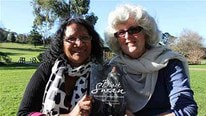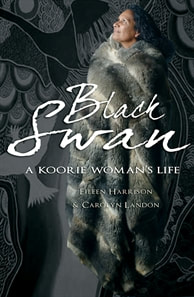 Eileen Harrison and Carolyn Landon with a copy of Black Swan: A Koorie Woman’s Life. Photo: Jem Wilson (ABC Gippsland)
Eileen Harrison and Carolyn Landon with a copy of Black Swan: A Koorie Woman’s Life. Photo: Jem Wilson (ABC Gippsland) Carolyn Landon’s biographies combine the personal and the political in compelling true stories.
 Black Swan: A Koorie Woman’s Life is published by Allen & Unwin. It was shortlisted for the 2012 WA Premier's Book Awards.
Black Swan: A Koorie Woman’s Life is published by Allen & Unwin. It was shortlisted for the 2012 WA Premier's Book Awards. By Anne Paul
I FIRST met Carolyn Landon in 2008 at the launch of her book Cup with No Handles. The book was a memoir of a Warragul woman, Bette Boyanton, one of the founding mothers of the Neighbourhood House movement and a driving force behind the establishment of the Warragul Neighbourhood House.
However, the book was much more, with an engaging narrative that provides a cameo of the social history of Melbourne and Gippsland from the Great Depression, woven into the personal journey of one woman as she struggled to overcome poverty, poor education and disadvantage, and worked toward social reform.
Since then I have read two of Carolyn’s earlier books, Jackson’s Track – Memoir of a Dreamtime Place,2000, and Jackson’s Track Revisited, 2006. The first is the memoir of Daryl Tonkin, who lived and worked in the forests of West Gippsland. It is a complex book that tells of the harsh life of the timber worker, his relationship with Gippsland’s indigenous people and his love for his partner Euphie, an indigenous woman, and the racism they and their children experienced.
Jackson’s Track Revisited gives voice to more of the players from the original memoir, within the context of the history and dynamics of the mid-20th century assimilation policy in Australia.
For me, the stories opened a door on a part of our history of which I had little knowledge. It’s sad to reflect on the collective blindness of most Victorians and Gippslanders to this recent history, beyond a cursory awareness of Lake Tyers Mission.
It was therefore with much anticipation that I commenced Carolyn’s latest book, Black Swan – A Koorie Woman’s Life, published in 2011. It’s a beautiful book, elegantly illustrated and designed.
The book was co-written with Eileen Harrison, who grew up at Lake Tyers Mission in the 1950s and takes us on her life journey, interwoven with her art work. I have just completed it and was in tears as I read about her life-changing cochlear implant, and the power of her art as well as the joy of being one of the 48 elders wearing possum skin cloaks at the opening ceremony of the Commonwealth Games in 2006.
While the memoir has some truly heart-wrenching accounts of her life as a child, young woman and mother, and the forces that played on her family and community, it also provided me with hope. Hope that through knowledge and understanding we can progress as an inclusive community.
I think Carolyn has provided so much for the Gippsland community, first as a teacher then in guiding the writing of this book and nurturing Eileen to share her story.
The importance of this work is best summed up by Eileen’s closing words as she describes the Commonwealth Games ceremony.
“There we were, all us women experiencing that powerful feeling … everything I had been through … but I’m a good powerful person. My culture is powerful and important and the beginning of the world. There would have been so many people in that audience who had no idea who we were and there we were telling them … I felt then that no one could say I was nothing ever again.
We are fortunate to have Carolyn Landon living in the Bass Coast community. I know she is soon to publish her next book on the life of botanical artist Celia Rosser. I urge people to read Black Swan first.
I FIRST met Carolyn Landon in 2008 at the launch of her book Cup with No Handles. The book was a memoir of a Warragul woman, Bette Boyanton, one of the founding mothers of the Neighbourhood House movement and a driving force behind the establishment of the Warragul Neighbourhood House.
However, the book was much more, with an engaging narrative that provides a cameo of the social history of Melbourne and Gippsland from the Great Depression, woven into the personal journey of one woman as she struggled to overcome poverty, poor education and disadvantage, and worked toward social reform.
Since then I have read two of Carolyn’s earlier books, Jackson’s Track – Memoir of a Dreamtime Place,2000, and Jackson’s Track Revisited, 2006. The first is the memoir of Daryl Tonkin, who lived and worked in the forests of West Gippsland. It is a complex book that tells of the harsh life of the timber worker, his relationship with Gippsland’s indigenous people and his love for his partner Euphie, an indigenous woman, and the racism they and their children experienced.
Jackson’s Track Revisited gives voice to more of the players from the original memoir, within the context of the history and dynamics of the mid-20th century assimilation policy in Australia.
For me, the stories opened a door on a part of our history of which I had little knowledge. It’s sad to reflect on the collective blindness of most Victorians and Gippslanders to this recent history, beyond a cursory awareness of Lake Tyers Mission.
It was therefore with much anticipation that I commenced Carolyn’s latest book, Black Swan – A Koorie Woman’s Life, published in 2011. It’s a beautiful book, elegantly illustrated and designed.
The book was co-written with Eileen Harrison, who grew up at Lake Tyers Mission in the 1950s and takes us on her life journey, interwoven with her art work. I have just completed it and was in tears as I read about her life-changing cochlear implant, and the power of her art as well as the joy of being one of the 48 elders wearing possum skin cloaks at the opening ceremony of the Commonwealth Games in 2006.
While the memoir has some truly heart-wrenching accounts of her life as a child, young woman and mother, and the forces that played on her family and community, it also provided me with hope. Hope that through knowledge and understanding we can progress as an inclusive community.
I think Carolyn has provided so much for the Gippsland community, first as a teacher then in guiding the writing of this book and nurturing Eileen to share her story.
The importance of this work is best summed up by Eileen’s closing words as she describes the Commonwealth Games ceremony.
“There we were, all us women experiencing that powerful feeling … everything I had been through … but I’m a good powerful person. My culture is powerful and important and the beginning of the world. There would have been so many people in that audience who had no idea who we were and there we were telling them … I felt then that no one could say I was nothing ever again.
We are fortunate to have Carolyn Landon living in the Bass Coast community. I know she is soon to publish her next book on the life of botanical artist Celia Rosser. I urge people to read Black Swan first.